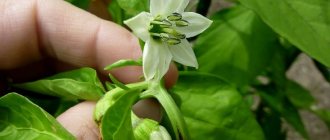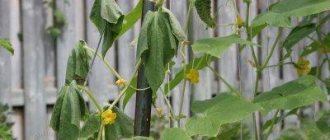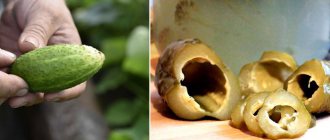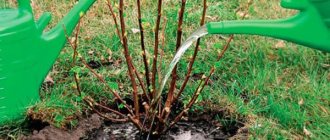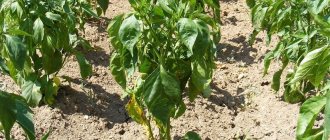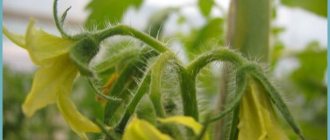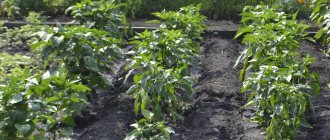Rot equally often affects peppers both in greenhouses and in open ground. It is especially unpleasant to encounter this problem right at the finish line - at the moment of fruit formation and harvest ripening. Let's look at the most common causes of rotting pepper fruits right on the bush.
The main reason for the appearance of rot on peppers is, of course, the causative agents of a variety of diseases, which the fleshy fruits of this plant attract like a magnet. Still, don’t rush to run for the sprayer! Perhaps the reason for such “inappropriate behavior” of peppers lies in something else, for example, improper care or inability to organize pest prevention.
That is why it is important to be able to distinguish rot that appears on fruit due to disease from rot caused by something else.
Causes
Dry or crown rot is a physiological disease. This means that pathogenic microorganisms are not to blame for its occurrence. Infection often invades the affected area, but is a consequence, not a cause.
In fact, blossom end rot on peppers and other nightshades is nothing more than an external manifestation of calcium starvation. It can even occur on limestone soils that suffer from an excess rather than a deficiency of the element.
Calcium deficiency
All plants, including peppers, get calcium from the soil. It moves along the main shoot to the top, then flows into the leaves, and only from there it is distributed into flowers and ovaries. And it doesn’t always reach the ends of the fruit.
There is usually a lot of calcium in soil and water, but it is difficult for plant organisms to access. From lime and dolomite flour, it must first go into the soil, and only then will it be absorbed by the roots, and this will take time.
Many gardeners believe that when using a complex fertilizer, they definitely gave the peppers all the necessary nutrients. This is wrong. Calcium is rarely included in their composition, since it is poorly absorbed simultaneously with sulfur, magnesium, sodium, and certain forms of nitrogen. And potassium is generally an antagonist of calcium, making it unavailable.
That is why the use of ash, which contains a lot of K and doses of Ca sufficient for pepper, does not save against blossom end rot. Potassium begins to act immediately after application, calcium - in the next season, if it is not blocked again.
Spots on peppers are not the only consequences of a lack of an element. Calcium is involved in all processes occurring in the plant:
- in photosynthesis;
- it is he who helps to absorb other nutrients;
- regulates all biochemical processes;
- participates in the synthesis of proteins and vitamins;
- reduces soil acidity.
If nitrogen is the building blocks for a plant, then calcium is the cement that holds everything together.
Hot summer disease
This is what blossom end rot is called when talking about peppers. The expression is not used regarding tomatoes. Why?
Peppers are much more sensitive to lack of moisture. They tolerate heat less well and require shorter daylight hours than tomatoes. The crop in the south is often planted compactly so that the upper leaves protect the fruit, or under the cover of large plants that cast shade on the pepper during the midday hours.
To cure tomatoes, the bushes also protect from heat and be sure to regulate watering. But calcium supplements play a decisive role in the fight against the disease.
For peppers, all factors are equivalent:
- Ca deficiency;
- heat;
- insufficient or uneven watering.
Other reasons
The occurrence of calcium starvation is favored by:
- any damage to the root system;
- saline soil;
- excess nitrogen.
Why do bell peppers rot on the bushes?
There may be many reasons why the fruits of sweet peppers in open ground or a greenhouse begin to rot:
- waterlogging of the soil, which does not have time to dry out between waterings;
- high humidity at high air temperatures, which is possible in poorly ventilated greenhouses;
- increased soil acidity, which is a good environment for the development of fungi;
- decaying burns from direct sunlight;
- constant dampness in a greenhouse or greenhouse;
- watering with cold water;
- lack of calcium and excess nitrogen in the soil.
As a result of the described unfavorable factors, plants are affected by fungal diseases, which causes their fruits to become rotten.
Signs of blossom end rot
In tomatoes, the probability of topping can be determined by simply reading the description of the variety:
- cherry tomatoes practically do not get sick, while long-fruited or beefy ones are almost guaranteed to rot;
- pink and yellow ones have to be treated more often than red ones, while black ones are affected extremely rarely.
There is no such pattern for peppers. Bitter ones suffer from crown rot just like sweet ones. The wall thickness, size, and shape of the fruit do not add resistance; prism-shaped, Bulgarian, cubic, heart-shaped or pumpkin-shaped varieties with an elongated and depressed nose are equally often affected.
The first sign of incipient blossom end rot is weeping dark spots 5 mm in diameter. In peppers they are usually located on the sides, rarely in the area of the nose. Then the marks increase in size, become dry, rough, and look like burns.
Over time, as can be seen in the photo, the stain is pressed in and the tissue dies. The affected fruits stop increasing in size and quickly acquire the color characteristic of the variety, but the wall remains thin. The seeds turn brown and are unsuitable for further propagation.
Expert opinion
Maria Nikolaevna
Experienced vegetable grower, gardener, 40 years of experience.
Ask a Question
It is no longer possible to save diseased peppers. It is better to cut them off before the start of treatment, so as not to interfere with the growth of new, healthy ovaries.
Brown spot (cladosporiosis)
The causative agent of the disease is the fungus Fulvia fulva.
It gets into the greenhouse with the soil, on the gardener’s clothes or through dirty tools. It begins to actively reproduce at high humidity combined with heat. Signs of brown spot are brown spots on the outside of the leaves and a gray-white fluffy coating on the inside. As the disease progresses, the fruits gradually turn black and rot.
You can protect plantings from cladosporiosis using a set of measures:
- Spring treatment of walls and soil in the greenhouse with fungicides;
- Maintaining humidity no more than 70% and temperature no higher than 28 degrees;
- Treatment of plants with copper-containing preparations. According to reviews from gardeners, spraying pepper bushes with Zaslon, Barrier works well against brown spot.
Ways to fight
Peppers in greenhouses, open and protected ground suffer from blossom-end rot. But it is easier to deal with the problem in greenhouses - there, at least, the wind does not blow moisture out of the soil, and it is easier to protect the crop from the sun.
To save peppers from blossom end rot, you definitely need to adjust their care. There will be no benefit from calcium supplements alone.
Treatment of blossom end rot should be comprehensive. Need to:
- feed the pepper with calcium in an easily accessible form at the root;
- treat the above-ground part;
- improve the soil;
- adjust watering;
- protect the bushes from the heat.
Drugs
A chemical fertilizer containing Ca in an easily accessible form is calcium nitrate. The rest release the element for a long time; they will not have time to help in the treatment of blossom end rot.
Be sure to do root feeding and leaf spraying at the same time. The first one acts slowly, but the effect lasts a long time. The second is a kind of “first aid”, it is absorbed and excreted by plants quickly, but manages to stop the development of blossom end rot until the fertilizer applied to the soil begins to work.
10-15 g of the drug are dissolved in 10 liters of water and watered at the root of the peppers. Depending on the height, 3-5 liters are spent on an adult bush; for newly established seedlings, 1 liter will be enough.
The same concentration of solution is needed for foliar treatment. To increase its effectiveness, it is recommended to add 2 caps of Dimexide to a 10-liter cylinder. The drug itself is not a medicine, but it will help calcium penetrate into the cell.
There are two more significant points that should not be forgotten when using calcium nitrate: First, Ca is incompatible with K. What to do? Spread out the introduction of elements over time. First, the peppers are given calcium, and after 1-3 days they can be fertilized with potassium.
The K:Ca ratio should be 10:7. This is the only way to achieve the correct balance of nutrients.
Second point. Calcium nitrate contains nitrogen. If the pepper is deficient in nitrates, give it without fear; it develops normally - with caution.
But blossom end rot can be caused by excess nitrogen, and adding it additionally is unacceptable. You will have to forget about calcium nitrate and turn to folk remedies.
Folk remedies
If used correctly, they are no less effective than Ca(NO3)2, you just need to tinker a little. Calcium contains:
- chalk;
- eggshell;
- dolomite flour;
- lime.
It needs to be translated into an accessible form. For this:
- A tablespoon of raw material is poured with 500 ml of vinegar.
- When the mixture stops foaming, dilute with 10-12 liters of water.
- Water or process the peppers.
Citric acid cannot be used instead of vinegar.
Soil not suitable for the crop
Pepper is extremely demanding on the composition and acidity level of the soil.
The culture prefers loose, breathable, nutritious soil with an acidity level of 6.2 to 6.8. When planted in a dense, clayey, acidic substrate, the roots begin to rot. This affects the general condition of the plant. It will not be possible to get healthy fruits from bushes with an undeveloped root system.
To get fully developed plants with strong immunity, fill the beds in the greenhouse with the “right” soil, loose, moisture- and breathable, enriched with nutrients. For 1 sq/m. add 5–6 kg of bed area. humus or compost, 1 bucket of coarse river sand, 1 glass of wood ash and superphosphate and 25 g of ammonium nitrate. Mix all ingredients well.
Expert opinion
Mishina Valentina Georgievna
Gardener with 20 years of experience and rich experience
Prepare the rows in the fall or 2 - 3 weeks before the intended planting of pepper seedlings. A day before planting, water the soil with a strong solution of potassium permanganate.
Preventive actions
The best prevention of blossom end rot is proper agricultural technology. First of all, you should improve the soil by adding calcium-containing substances during autumn digging. By the time the pepper is planted, the element will be in an accessible form.
The occurrence of the disease is prevented by:
- uniform watering;
- balanced feeding;
- protecting plants from heat, in greenhouses - by whitewashing the ceiling and part of the walls, in the garden - using shading nets, compacted planting.
Of course, it is unpleasant when peppers are affected by blossom end rot. But there is a treatment method that allows you to save at least part of the harvest. And if you follow the rules of agricultural technology, the proportions and procedure for applying fertilizers, the disease will not manifest itself at all. It is non-infectious in nature and cannot be carried from a neighboring area by wind, birds, animals, or hide in the ground.
What conditions are needed for the growth of sweet peppers?
Pepper loves light, warmth, moist and nutritious soil. Excess water, drafts, and cold can harm plants. To grow a good crop of vegetables, you need a balance of temperature and humidity. Without these conditions, peppers' immunity decreases and they get sick more often.
Necessary conditions for growing pepper:
- light porous soil;
- air temperature 20-25*C;
- air humidity no more than 60%;
- water only when the soil dries out;
- ventilation, fresh air;
- soil temperature 24*C.
Bacterial cancer
A disease caused by the bacterium Clavibacter michiganensis. Initially, irregularly shaped areas of dark brown color with a light center appear on the leaves. Gradually, the affected areas of tissue merge and take on the appearance of crusted areas. Spots with a brown center and a white edge appear on the fruits.
The development of the disease is facilitated by high air humidity, more than 70%, and a temperature of +28 degrees. Prevention of the disease is to maintain a microclimate in the room that is comfortable for peppers and treat them with copper-containing fungicides.
Pests
Slugs
Caterpillars
Woodlice
Pepper has enough enemies - those who like to feast on the juicy pulp. All kinds of slugs, caterpillars, woodlice gnaw small holes on the walls of the fruit and penetrate inside. As a result of their vital activity, the pepper begins to rot.
Expert opinion
Mishina Valentina Georgievna
Gardener with 20 years of experience and rich experience
If you notice fruits with small holes, remove them from the beds. To protect against pests, place traps in the greenhouse. Cut plastic bottles in half, dig to the brim into the soil in the pepper beds and fill 1/3 with beer or sweet liquid. The devices work well against slugs and woodlice. Pests enter the liquid, attracted by the smell, and die. The contents of the traps need to be changed every 3 to 4 days.


